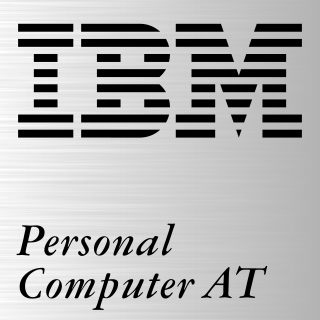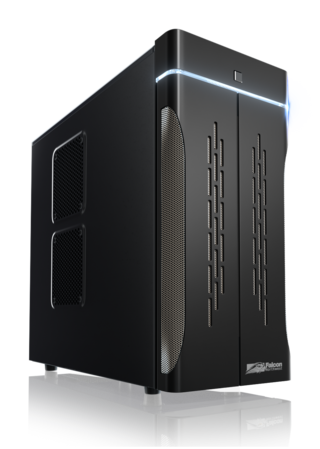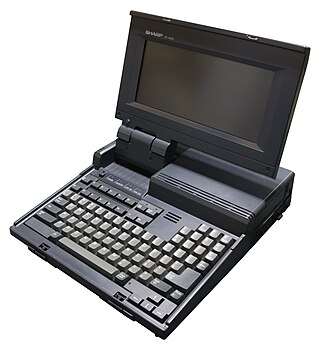
Micro Channel architecture, or the Micro Channel bus, is a proprietary 16- or 32-bit parallel computer bus publicly introduced by IBM in 1987 which was used on PS/2 and other computers until the mid-1990s. Its name is commonly abbreviated as "MCA", although not by IBM. In IBM products, it superseded the ISA bus and was itself subsequently superseded by the PCI bus architecture.

The Personal System/2 or PS/2 is IBM's second generation of personal computers. Released in 1987, it officially replaced the IBM PC, XT, AT, and PC Convertible in IBM's lineup. Many of the PS/2's innovations, such as the 16550 UART, 1440 KB 3.5-inch floppy disk format, 72-pin SIMMs, PS/2 port, and VGA video standard, went on to become standards in the broader PC market.

The IBM Personal Computer AT was released in 1984 as the fourth model in the IBM Personal Computer line, following the IBM PC/XT and its IBM Portable PC variant. It was designed around the Intel 80286 microprocessor.

In personal computing, a tower unit, or simply a tower, is a form factor of desktop computer case whose height is much greater than its width, thus having the appearance of an upstanding tower block, as opposed to a traditional "pizza box" computer case whose width is greater than its height and appears lying flat.

The PS/2 E or Energy is a member of the IBM Personal System/2 family of personal computers (PCs). It was the first Energy Star-compliant PC, consuming very little power relative to other contemporary PCs, and made extensive use of recycled materials in its enclosure.

The Deskpro 386 is a line of desktop computers in Compaq's Deskpro range of IBM PC compatibles. Introduced in September 1986, the Deskpro 386 was the first personal computer to feature Intel's 32-bit 80386 microprocessor. It also marks the first time that a major component of the IBM Personal Computer de facto standard was updated by a company other than IBM themselves—in this case, upgrading from the 80286 processor of the Personal Computer/AT.

The IBM Personal Computer XT is the second computer in the IBM Personal Computer line, released on March 8, 1983. Except for the addition of a built-in hard drive and extra expansion slots, it is very similar to the original IBM PC model 5150 from 1981.

The IBM Thinkpad 350 series was a notebook computer series introduced in 1993 by IBM as part of their Thinkpad laptop series. It was the successor to the IBM ThinkPad 300. With only 2 models ever made in the series, it was succeeded in 1994 by the IBM Thinkpad 360 series.
The IBM PS/2 portables are Micro Channel architecture-based, portable PS/2 computers released by IBM in 1989.

Reply Corporation, often shortened to Reply Corp., was an American computer company based in San Jose, California. Founded in 1988 by Steve Petracca, the company licensed the Micro Channel architecture from IBM for their own computers released in 1989, competing against IBM's PS/2 line. The company later divested from offering complete systems in favor of marketing motherboard upgrades for older PS/2s. Reply enjoyed a close relationship with IBM, owing to many of its founding employees, including Petracca, having worked for IBM. The company was acquired by Radius in 1997.

The Sharp PC-4500 is a line of laptop computers released by Sharp Corporation in 1987. The line comprises the PC-4501, the PC-4502, and the PC-4521. The PC-4501 is a bare-bones unit with only 256 KB of RAM stock, only one floppy drive, no backlighting, and no built-in numeric keypad; the PC-4502 and PC-4521 bumps the stock RAM to 640 KB and includes the latter two features while providing either two floppy drive (PC-4502) or one floppy drive and a 20 MB hard drive (PC-4521). Prices on the line initially ranged from $1,295 to just under $3,000; the PC-4501 was later sold for $995, becoming one of the first sub-$1,000 laptops available on the market. The PC-4500 line received mixed, mostly positive, reviews on its release in September 1987.

The Personal System/2 Model 30 and Personal System/2 Model 30 286 are IBM's entry-level desktop computers in their Personal System/2 (PS/2) family of personal computers. As opposed to higher-end entries in the PS/2 line which use Micro Channel bus architecture, the Model 30 features an Industry Standard Architecture bus, allowing it to use expansion cards from its direct predecessors, the PC/XT and the PC/AT. The original PS/2 Model 30, released in April 1987, is built upon the Intel 8086 microprocessor clocked at 8 MHz and features the 8-bit ISA bus; the Model 30 286, released in September 1988, features the Intel 80286 clocked at 10 MHz and includes the 16-bit ISA bus.

The Personal System/2 Model 25 and its later submodels the 25 286 and 25 SX are IBM's lowest-end entries in the Personal System/2 (PS/2) family of personal computers. Like its sibling the Model 30, the Model 25 features an Industry Standard Architecture bus, allowing it to use expansion cards from its direct predecessors, the PC/XT and the PC/AT—but not from higher entries in the PS/2 line, which use Micro Channel. Unlike all other entries in the PS/2 line, the Model 25 and its submodels are built into an all-in-one form factor, with its cathode-ray tube (CRT) monitor and system board occupying the same enclosure. IBM oriented the Model 25 at home office workers and students.

The Personal System/2 Model 55 SX is a midrange desktop computer in IBM's Personal System/2 (PS/2) family of personal computers. First released in May 1989, the Model 55 SX features an Intel 386SX processor running at a clock speed of 16 MHz. In October 1990, IBM introduced a diskless workstation version of the Model 55 SX, called the Personal System/2 Model 55 LS. The Model 55 SX was the best-ever selling computer in the PS/2 range, accounting for 23 percent of IBM's PC sales within four months of its introduction. By 1991, the PS/2 Model 55 SX was the best-selling x86-based PC in the world.

The Personal System/2 Model 60 is a high-end desktop computer in IBM's Personal System/2 (PS/2) family of personal computers. First released in April 1987, the Model 60 features an Intel 80286 processor running at a clock speed of 10 MHz, the same as its midrange counterpart, the Personal System/2 Model 50. Unlike the Model 50, the Model 60 was built into a tower case and featured four more 16-bit MCA expansion slots and an additional drive bay. The Model 60 was IBM's first Intel-based PC built into a tower form factor and was influential in popularizing towers in computer case design.

The Personal System/2 Model 70 386 and Personal System/2 Model 70 486 are midrange desktop computers in IBM's Personal System/2 (PS/2) family of personal computers. The PS/2 Model 70 386, released in April 1987, features an Intel 386 microprocessor clocked between 16 MHz and 25 MHz and features the 32-bit Micro Channel architecture (MCA) bus; the Model 70 486, released in December 1989, features the Intel 486 clocked at 25 MHz and also includes the 32-bit MCA bus. The latter is essentially a Model 70 386 with the 486/25 Power Platform pre-installed; this was a CPU upgrade card for the Model 70 386 released earlier in October 1989 that was the first commercially available product to use the 486 processor. Both editions of Model 70 are housed in the same case as the earlier PS/2 Model 50 from 1987.

The Personal System/2 Model 80 is a high-end desktop computer in IBM's Personal System/2 (PS/2) family of personal computers. First released in July 1987, the Model 80 features the 32-bit Intel 386 processor running at a clock speed of 16 MHz. The Model 80 was built into a tower case, the same one as its 16-bit counterpart the PS/2 Model 60. It sports several 32-bit MCA expansion slots—the only PS/2 model to sport such slots at the time of its release—and between five to six drive bays. The PS/2 Model 80 was the highest-end PS/2 in the original 1987 line-up and was IBM's first PC based on the 386 processor. The Model 80 received several updates over the course of its lifespan, increasing the computer's hard drive capacity as well as the clock speed of its processor and the maximum supported RAM. IBM discontinued the Model 80 in 1992.

Aox Inc. was a privately run American technology corporation founded by Michael and Linda Aronson in 1978. Over the course of its 22-year lifespan, the company chiefly developed software and hardware for IBM's PC and compatibles, for the Personal System/2, and for the Macintosh. In its twilight years, the company designed multimedia and teleconferencing devices and chip designs. Aox was founded after Michael Aronson graduated from Harvard University with a doctorate in physics; he stayed with the company until 2000, when he incorporated EndPoints Inc. and switched to full-time fabless semiconductor design.

Cumulus Corporation was an American computer peripheral and system manufacturer active from 1987 to 1993. Based in Beachwood, Ohio and started by Tecmar founder Martin Alpert, the company set out to exclusively manufacture expansion products for IBM's Personal System/2 (PS/2) family of computers—mainly RAM expansion cards. It later released cross-platform CPU upgrade cards and memory expansion cards for other platforms besides the PS/2. Beginning in 1990, the company began trading as Cumulus Computer Corporation and began releasing complete systems of their own. Initially a success story for the tech industry in Cleveland, a botched stock launch in 1992 proved disastrous for the company's ailing cash flow situation, and in 1993 the company was liquidated amid massive debt to suppliers and lenders.




















